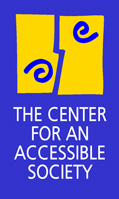
DISABILITY
ISSUES
INFORMATION
FOR JOURNALISTS
ABOUT
THE CENTER
Wed, 4 Jun 2003 -- Media Matters No. 29:
How to release your reportThis is the fourth Media Matters devoted to gaining media attention for your research report. Thanks to the SPIN Project, from which much of this material was taken.
Our last Media Matters looked at ways to structure your report itself to maximize a reporter's or editor's interest.
Once your report is ready to be released, you need to consider whether you'd get better media attention by releasing it to a few key reporters, or by mounting an all-out media campaign. Today we'll look at working with key reporters.
Some reports may require a low-key approach, such as briefing one or two cultivated reporters to place a story.
Placing the report with key journalists, you will most likely do so through a "media briefing" with the reporter -- or a small collection of reporters and editors. Your existing relationships with reporters will play a large role in getting coverage through this approach. If you already have good working relationships with journalists whose "beats" involve your research area -- and the reporters can be likely counted on to see your report as newsworthy, this is a good route to take. It requires fewer resources and can produce good results.
Another strategy is to "leak" the news to one key reporter. For this strategy to succeed, however, you must be fairly sure the reporter who's getting the report will actually do a story about it. "Leaking" a story is done BEFORE the release date: So, if you use this strategy, list the publication date on your report as June 20, but "leak" the report to your key journalist on June 16 -- time enough for her to get a story into the news on the official "release date." On June 20, you can hold a media event to release it to everyone else.
Cautionary note: Exclusives can produce positive and negative fallout.
Positive: The exclusive results in the publication of a full article in advance that could trigger pack-journalism coverage of your media event to release the report by reporters who don't want to risk being left out. Negative: Even though this strategy is common and not considered "deceptive", the exclusive often causes other journalists to be irritated, or worse. If they know they were intentionally scooped on a good story, you may have some feelings to attend to.
Do not give an exclusive to more than one media outlet. If you are going to provide an exclusive, make sure it is to the right media outlet in terms of size and reach of audience.
Is your news national in scope with local tie-ins, or local with national implications? Along with your budget and resources, this will determine what kind of media effort to unleash.
If the report is national in nature, consider one national media event -- usually in Washington, D.C. -- with coordinated local media events. If the report is local in nature, emphasize the national implications of the findings in terms of how other states or communities deal with the issue and how your report affects the national debate.
We'll look at the media campaign in our next "Media Matters."
Contact us at info@accessiblesociety.org